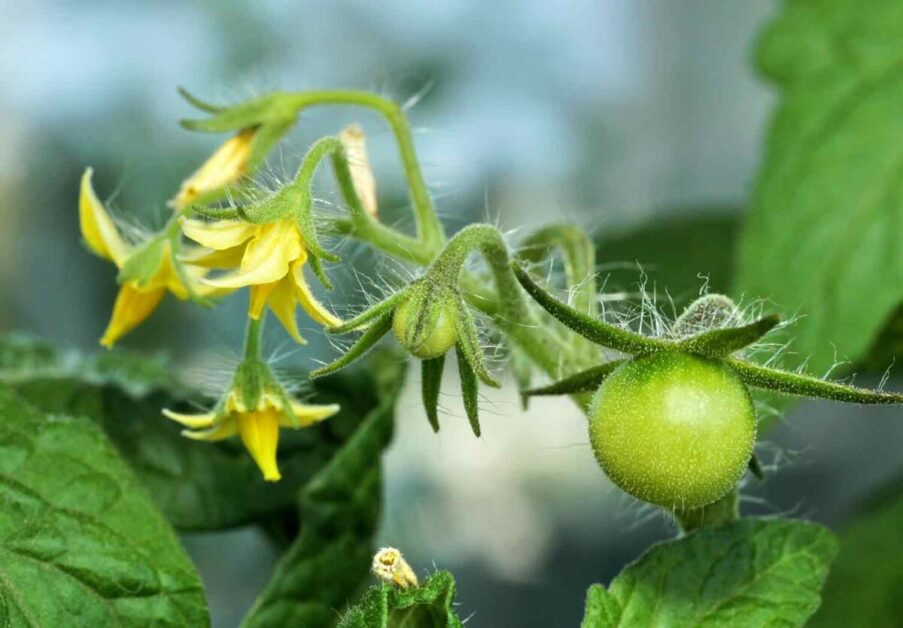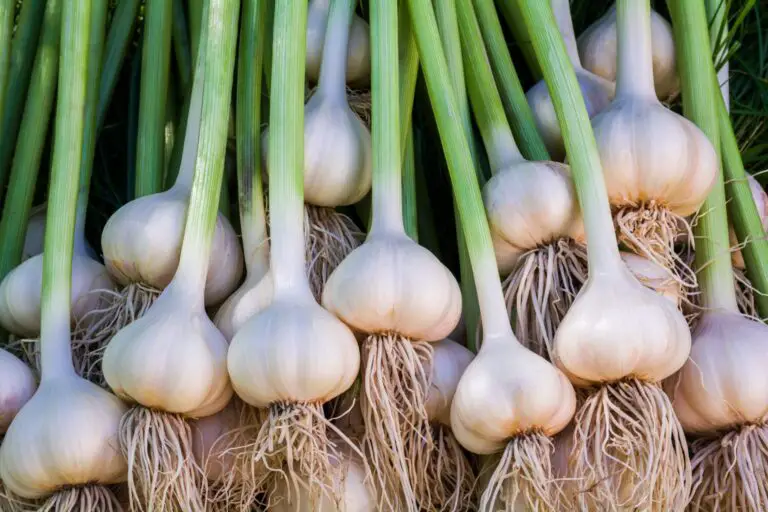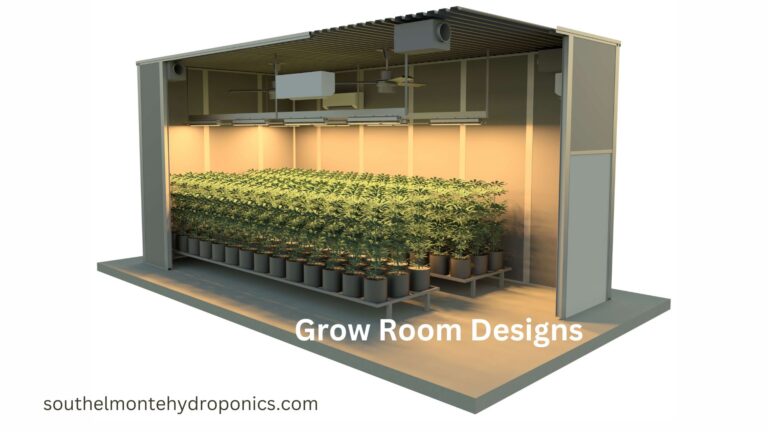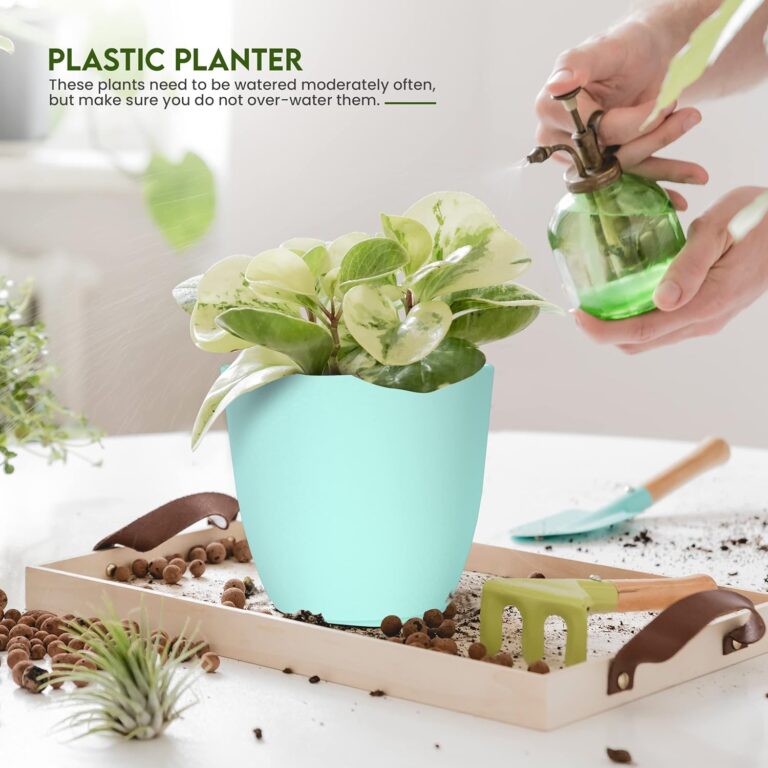Why Isn’t My Tomato Plant Flowering This Season?
Understanding the Tomato Plant’s Reproduction Process
Botanists and horticulturists have long been fascinated by the reproductive process of tomato plants. Understanding how these plants reproduce is essential for any gardener looking to grow healthy and productive tomato crops. The tomato plant’s reproduction process involves several distinct stages, each playing a crucial role in the development of the fruit.

Firstly, tomato plants go through the process of pollination. This occurs when pollen, containing the male gametes, is transferred from the stamen to the stigma. This can happen through self-pollination, where the pollen is transferred from the anther of one flower to the stigma of the same flower, or through cross-pollination, where pollen is transferred between different flowers. Once pollination occurs, the male gametes fertilize the female gametes, leading to seed development within the fruit. In the absence of pollination, tomato plants may still produce fruit but not with the same vigor or quality. Understanding the pollination process and its significance is crucial for any gardener aiming to maximize their tomato plant’s reproductive success.
Identifying Common Factors That Affect Tomato Plant Flowering
Tomato plant flowering is a critical stage in the growth and development of these beloved fruits. However, there are several common factors that can affect the flowering process and ultimately impact the yield of the tomato plants. One crucial factor is the role of temperature. Tomato plants are highly sensitive to temperature, and specific temperature ranges are optimal for flower formation. High temperatures above 85°F (29.4°C) can inhibit flower bud production, while temperatures below 55°F (12.8°C) can prevent flowers altogether. Therefore, maintaining a stable temperature within the ideal range of 70°F to 75°F (21.1°C to 23.9°C) is essential for promoting tomato plant flowering.
Another factor that can significantly impact tomato plant flowering is the lighting conditions they receive. Tomato plants require proper exposure to sunlight to initiate the flowering process. Lack of adequate sunlight or prolonged exposure to shade can result in delayed or reduced flowering. On the other hand, excessive light intensity can also hinder flower formation. It is crucial to find the right balance by providing tomato plants with around 8 to 10 hours of direct sunlight each day. Supplemental artificial lighting can be beneficial in situations where natural light is limited or inadequate, ensuring that the plants receive the necessary light energy for robust flowering. Additionally, it is essential to consider the quality of light, specifically the presence of blue and red light spectrum, as these wavelengths play a vital role in promoting flowering in tomato plants.
The table below some of the common issues regarding the flowering of tomato plant:
| Factors Affecting Tomato Plant Flowering | Description |
|---|---|
| Temperature | – Highly sensitive to temperature. |
| – Optimal range: 70°F to 75°F (21.1°C to 23.9°C). | |
| – High temps (>85°F or 29.4°C) inhibit flower bud production; low temps (<55°F or 12.8°C) prevent flowers. | |
| Lighting Conditions | – Proper sunlight exposure is crucial for flowering initiation. |
| – Inadequate sunlight or prolonged shade delays or reduces flowering. | |
| – Excessive light intensity can hinder flower formation. | |
| – Aim for 8 to 10 hours of direct sunlight daily. Supplemental artificial lighting may be needed in low-light conditions. | |
| – Consider blue and red light spectrum for optimal flowering, as these wavelengths are vital for the process. | |
| Nutrient Availability | – Adequate phosphorus, potassium, magnesium support flower development; deficiencies hinder flowering. |
| Watering Practices | – Consistent watering is crucial; irregular or excessive moisture can affect flowering. |
| Pruning and Suckering | – Proper pruning improves air circulation, sunlight penetration, supporting flower development. |
| Disease and Pest Management | – Timely control measures contribute to healthier plants and better flower production. |
| Varietal Differences | – Tomato varieties have varying flowering habits; choose those suited to your growing conditions. |
The Role of Temperature in Tomato Plant Flowering
Temperature plays a crucial role in the flowering process of tomato plants. As a heat-loving plant, tomatoes thrive in warmer temperatures, typically between 70°F and 85°F (21°C to 29°C). When the temperature falls below this range, it can significantly impact the plant’s ability to initiate and sustain flowering.
Low temperatures can hinder the production of hormones responsible for flower formation, leading to delayed or stunted flowering. In extreme cases, excessively cold temperatures can cause flower drop and even frost damage. Conversely, extremely high temperatures can also disrupt the flowering process, especially when they exceed 95°F (35°C). Heat stress can result in diminished flower production, poor fruit set, and reduced overall plant vigor.
To ensure optimal flowering, it is crucial to provide tomatoes with a controlled and consistent temperature environment. By monitoring and adjusting the temperature, whether through greenhouse management or other methods, gardeners can create an ideal climate that promotes healthy flower development and increased fruit yield. Understanding the impact of temperature on tomato plant flowering empowers gardeners to make informed decisions and implement effective strategies to maximize their plant’s reproductive potential.
How Light Conditions can Impact Tomato Plant Flowering
Light conditions play a crucial role in the flowering process of tomato plants. As photosynthetic organisms, tomatoes rely on light to produce energy through photosynthesis. Different light conditions can affect the plant’s growth and development, including the timing and abundance of flowering.
One important factor is the duration of light exposure. Tomato plants are generally classified as either “short-day” or “long-day” plants, depending on their response to light duration. Short-day plants require a certain period of darkness to trigger flowering, while long-day plants need a certain threshold of daylight hours. Understanding the specific light requirements of tomato varieties can help gardeners create optimal conditions for flowering. It is essential to provide the appropriate light exposure based on the type of tomato plants you are cultivating. This knowledge can significantly impact the success of your tomato harvest.
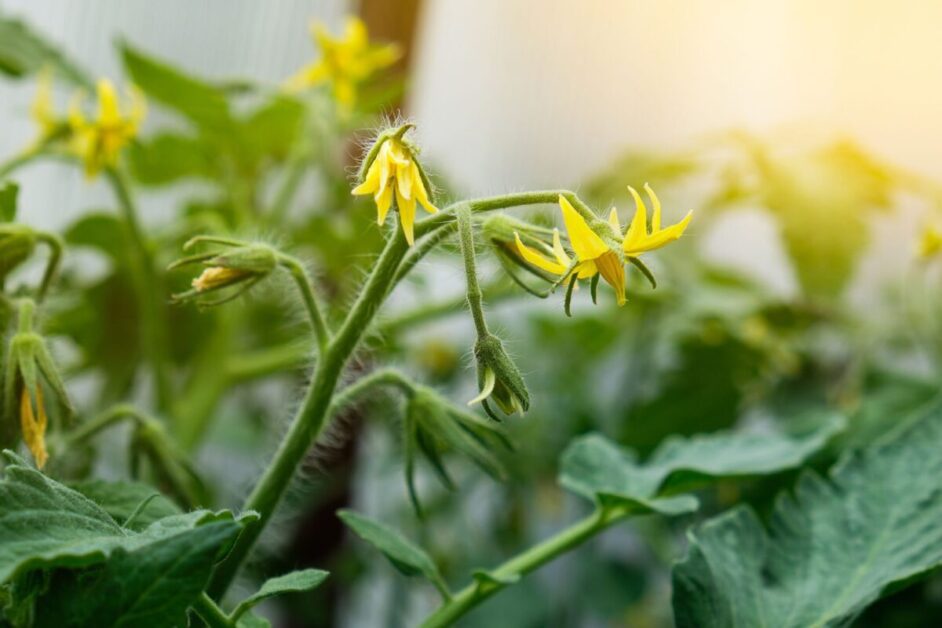
Additionally, the intensity of light is another crucial factor affecting tomato plant flowering. Insufficient light intensity can lead to sparse flowering or even the absence of flowers altogether. On the other hand, excessive light intensity can stress the plants and hinder their ability to flower. Gardeners should strive to strike a balance by providing an adequate amount of light without overwhelming the plants. This can be achieved by adjusting the distance between the light source and the tomato plants, using shading techniques, or investing in artificial lighting systems to supplement natural light when necessary.
By understanding the impact of light conditions on tomato plant flowering, gardeners can manipulate these factors to cultivate healthier and more productive plants. Properly timed and well-managed light exposure can improve the overall quality and quantity of tomato flowers, leading to an abundant harvest. It is essential to consider the specific light requirements of different tomato varieties and ensure an appropriate balance of light intensity to maximize flowering success. With the right light conditions, tomato plants can thrive and produce a bountiful yield for gardeners to enjoy.
The Importance of Proper Soil Nutrients for Tomato Plant Flowering
Proper soil nutrient management is essential for the healthy growth and optimal flowering of tomato plants. Nutrients are the building blocks that support various physiological processes in plants, including flower initiation and development. When tomato plants receive an adequate supply of nutrients, they can produce abundant and high-quality flowers, leading to a bountiful harvest.
One crucial nutrient for promoting tomato plant flowering is phosphorus. Phosphorus plays a vital role in energy transfer within the plant, which is necessary for the formation and development of flowers. It also aids in the transportation of sugars, carbohydrates, and other essential compounds that contribute to flower production. Insufficient phosphorus levels in the soil can result in reduced flowering and lower fruit yields. Therefore, it is crucial to ensure that the soil provides an ample supply of phosphorus to support the reproductive needs of tomato plants.
Another essential nutrient for tomato plant flowering is potassium. Potassium is involved in numerous physiological processes, including the regulation of water and nutrient uptake, enzyme activation, and protein synthesis. It also plays a key role in promoting flower formation and enhancing the quality of blossoms. Potassium deficiency can hinder the production of flowers, leading to poor fruit set and development. To foster healthy and productive tomato plants, it is imperative to maintain adequate potassium levels in the soil.
In addition to phosphorus and potassium, other essential soil nutrients for tomato plant flowering include nitrogen, calcium, and magnesium. Nitrogen is vital for the overall growth and development of plants, including leaf formation, which is crucial for photosynthesis and the production of energy needed for flowering. Calcium is necessary for maintaining the structural integrity of plant cells and is involved in hormone regulation, facilitating flower formation. Magnesium is important for chlorophyll synthesis and proper enzyme functioning, enabling efficient energy production for flower development.
Ensuring proper soil nutrient balance is crucial for enhancing tomato plant flowering. Conducting regular soil tests and incorporating organic matter into the soil can help maintain optimal nutrient levels. Additionally, using balanced fertilizers specifically formulated for tomatoes can provide the necessary nutrients for robust flower production. By addressing the soil’s nutrient requirements, gardeners can provide their tomato plants with the ideal conditions for abundant blooms and a successful harvest.
Watering Practices and Their Effect on Tomato Plant Flowering
Proper watering practices play a crucial role in ensuring optimal tomato plant flowering. Too much or too little water can significantly impact the plant’s ability to produce flowers. The goal is to maintain consistent soil moisture levels to provide an ideal growing environment for the tomato plants.
Overwatering can lead to root rot and suffocating the roots, hampering their ability to absorb oxygen. This can result in stunted growth and a reduced number of flowers. On the other hand, underwatering can cause stress for the plant, leading to wilting and decreased flower production.
To determine the appropriate watering schedule for your tomato plants, it is essential to consider environmental factors such as temperature, humidity, and soil type. Sandy soils tend to drain more quickly and may require more frequent watering, while clay soils retain moisture for longer periods and may need less frequent watering.
Monitoring the moisture levels in the soil is crucial. Stick your finger about an inch into the soil, and if it feels dry, it’s time to water. Avoid a strict watering schedule and instead adjust your watering practices based on the plant’s needs and the weather conditions. Providing adequate moisture while avoiding excessive waterlogging is the key to promoting healthy tomato plant flowering.
The Relationship Between Pruning and Tomato Plant Flowering
Pruning is an important practice in the care and maintenance of tomato plants, and it can have a significant impact on their flowering. When done correctly, pruning can promote better airflow, reduce disease risk, and improve overall plant health. It also plays a crucial role in redirecting the plant’s energy towards flower production. By removing unnecessary shoots and foliage, pruning allows the tomato plant to focus its resources on developing flowers and ultimately, fruits.
One key aspect to consider when pruning tomato plants is timing. It is generally recommended to begin pruning once the plant has established a sturdy stem and has developed a few sets of true leaves. Pruning too early in the plant’s growth can disrupt its development, while delaying pruning for too long can lead to excessive foliage growth and reduced flowering. It is best to strike a balance between allowing the plant enough time to establish itself and ensuring that pruning is done before excessive foliage growth hinders flowering.
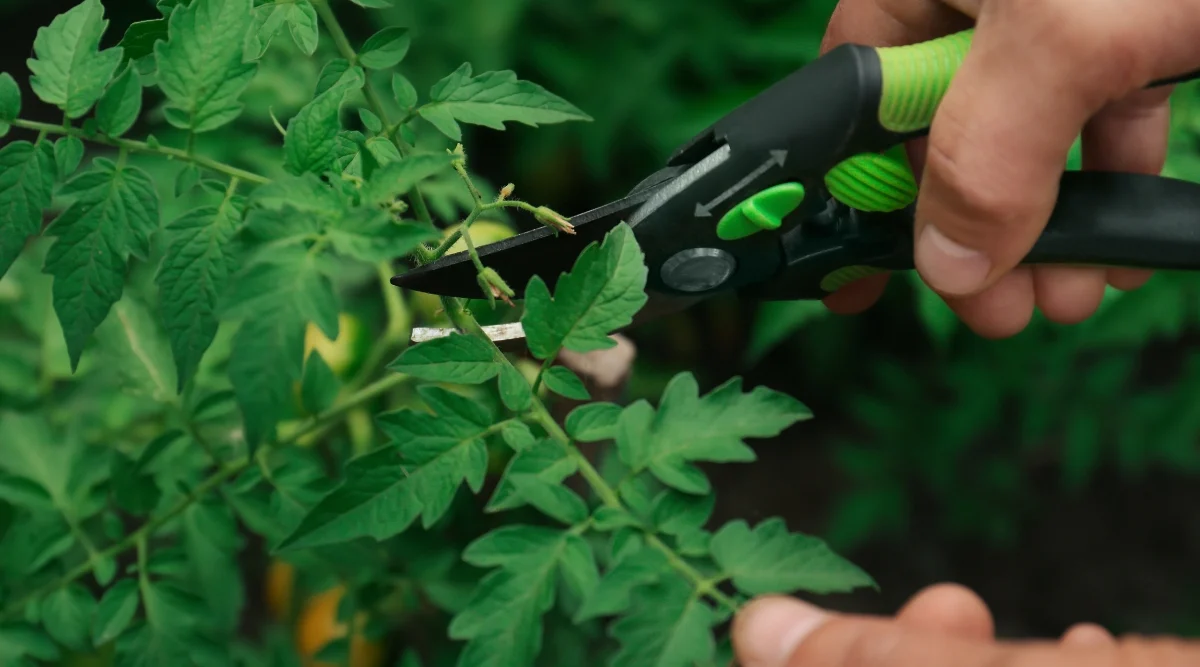
When pruning tomato plants, it is important to adopt proper techniques. Start by removing any suckers that emerge from the leaf axils, as these have the potential to divert energy away from flower production. Additionally, regularly remove any damaged, diseased, or yellowing leaves to prevent the spread of infections and ensure the plant’s resources are directed towards flower production.
In conclusion, pruning is a vital practice for promoting optimal tomato plant flowering. It allows for better air circulation, reduces disease risk, and directs the plant’s energy towards producing flowers. By timing pruning appropriately and employing proper techniques, gardeners can support their tomato plants in maximizing their flower production and, ultimately, enjoying abundant fruit harvests.
Examining the Influence of Tomato Plant Age on Flowering
Tomato plant age plays a significant role in determining when and how these plants flower. As tomato plants grow, they go through different stages of development, and each stage has a specific impact on their flowering process. Understanding the influence of tomato plant age on flowering can help gardeners make informed decisions about when to expect blooms and how to provide optimal conditions for flowering.
In the early stages of a tomato plant’s life, it primarily focuses on establishing a strong root system and developing its vegetative growth. During this phase, the plant directs its energy toward growing leaves, stems, and roots, rather than producing flowers. It is essential for gardeners to be patient and not force premature flowering through excessive fertilizer or other interventions. As the plant matures and reaches the appropriate age, typically around six to eight weeks, it naturally shifts its focus to reproductive growth, triggering the formation of flower buds. This transition is influenced by various environmental factors such as light, temperature, and nutrient availability. By understanding the influence of tomato plant age on flowering and providing the right conditions, gardeners can maximize the chances of a successful and abundant tomato harvest.
Pests and Diseases: Potential Causes of Tomato Plant Flowering Issues
Pests and diseases can significantly impact the flowering process of tomato plants, leading to reduced yields and poor fruit development. One common culprit is the tomato hornworm (Manduca quinquemaculata), a large caterpillar that feeds on tomato leaves and stems. Infected plants often exhibit stunted growth and reduced flowering, as the hornworms strip the plants of their vital nutrients.
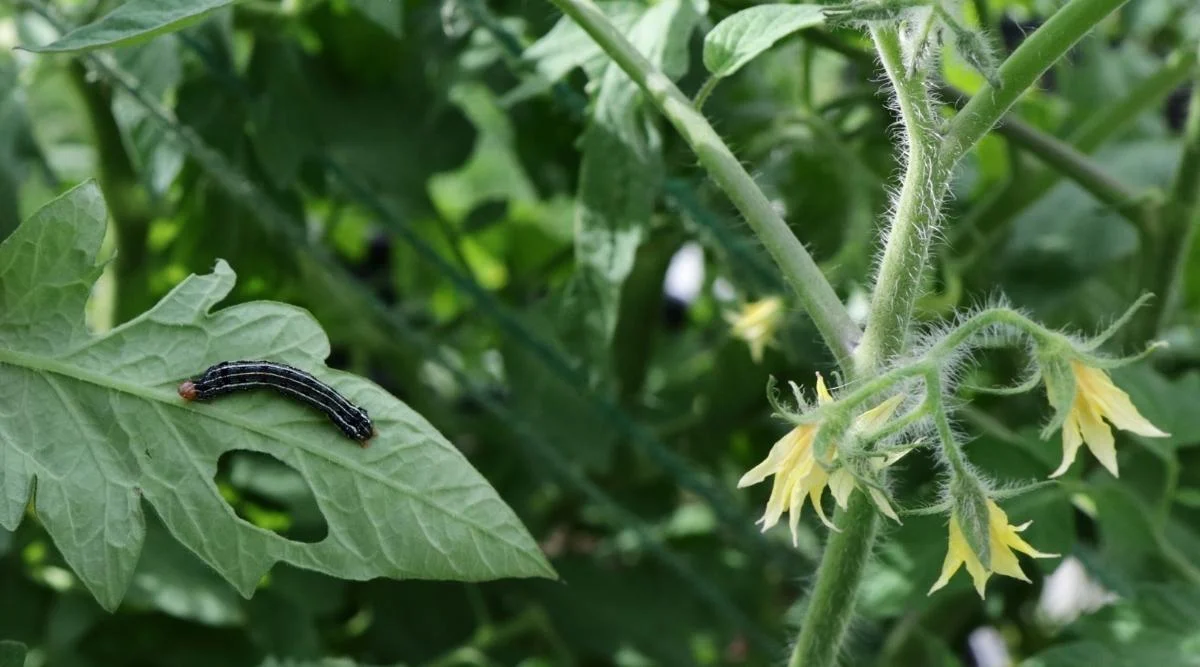
In addition to pests, diseases such as Fusarium wilt (Fusarium oxysporum) and bacterial canker (Clavibacter michiganensis subsp. michiganensis) can also hinder tomato plant flowering. Fusarium wilt, a soil-borne fungus, blocks the plant’s vascular system, causing wilting, yellowing leaves, and ultimately inhibiting flower formation. Similarly, bacterial canker infects the stems and leaves, leading to necrotic lesions and impaired nutrient transport, which negatively affects flowering.
Possible Effects of Overfertilization on Tomato Plant Flowering
Overfertilization can have detrimental effects on the flowering process of tomato plants. When too much fertilizer is applied, it can lead to an imbalance of nutrients in the soil, which can disrupt the plant’s natural growth and development. One of the potential effects of overfertilization is an excessive production of foliage at the expense of flower formation. The plant may focus its energy on vegetative growth instead of allocating resources towards the creation of flowers. This can result in a decreased number of flowers and ultimately, a reduced fruit set.
Another consequence of overfertilization is the increased risk of nutrient toxicity. Certain nutrients, such as nitrogen and phosphorus, are essential for plant growth, but when present in excess, they can have negative impacts. For instance, an excess of nitrogen can promote lush foliage growth while inhibiting flower and fruit development. Additionally, an imbalance in nutrient levels can disrupt the uptake and availability of other vital elements, further impairing the plant’s ability to flower properly.
To avoid the negative effects of overfertilization, it is crucial to follow recommended fertilization practices. Conducting soil tests can provide valuable insights into the nutrient profile of the soil, allowing gardeners to make informed decisions about the application of fertilizers. Additionally, it is essential to carefully read and follow the instructions on fertilizer labels, ensuring that the appropriate amounts are applied at the correct times. By practicing proper fertilization techniques and maintaining nutrient balance, gardeners can optimize tomato plant flowering and enhance fruit production.
The table below shows us the impacts of overfertilization:
| Effects of Overfertilization on Tomato Plant Flowering | Description |
|---|---|
| Excessive Foliage Production | – Overfertilization can lead to an imbalance of nutrients in the soil. |
| – Results in excessive foliage growth at the expense of flower formation. | |
| – Plant allocates energy to vegetative growth, reducing the number of flowers and ultimately impacting fruit set. | |
| Increased Risk of Nutrient Toxicity | – Excess nitrogen and phosphorus, essential nutrients, can lead to nutrient toxicity. |
| – Excess nitrogen promotes lush foliage, inhibiting flower and fruit development. | |
| – Imbalance disrupts the uptake and availability of other vital elements, impairing proper flower formation. | |
| Preventive Measures | – Conduct soil tests for valuable insights into nutrient profiles, aiding informed fertilization decisions. |
| – Read and follow fertilizer labels carefully, applying appropriate amounts at recommended times. | |
| – Practicing proper fertilization techniques and maintaining nutrient balance optimize tomato plant flowering and fruit production. |
Evaluating the Impact of Improper Pollination on Tomato Plant Flowering
Improper pollination can have a significant impact on tomato plant flowering and overall fruit production. Tomatoes are typically self-pollinating plants, but they can also benefit from cross-pollination by bees and other pollinators. When pollination is unsuccessful or incomplete, it can result in poor fruit set and reduced yields.
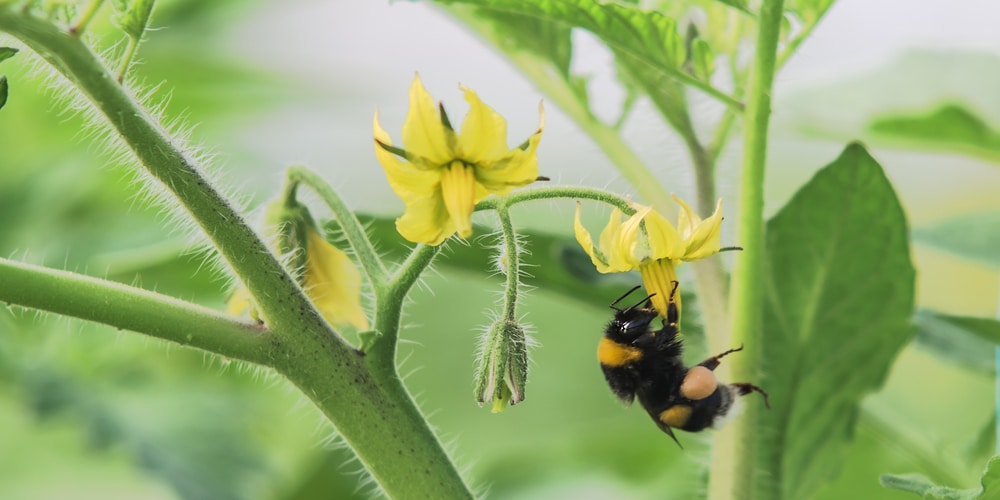
One of the main culprits of improper pollination is a lack of pollinators in the garden. Bees, butterflies, and other insects play a crucial role in transferring pollen from the male to the female parts of the tomato flowers. If there is a shortage of pollinators in your area, you may need to take steps to attract them to your garden. Planting pollinator-friendly flowers, providing them with water sources, and avoiding the use of pesticides can help increase bee and insect activity in your garden, thus improving the chances of successful pollination. Additionally, hand pollination can be an effective method for ensuring proper pollination, especially in greenhouses or enclosed growing environments where pollinators may be limited.
The Connection Between Stress and Tomato Plant Flowering
Stress is a significant factor that can impact the flowering of tomato plants. When tomato plants experience stress, such as extreme temperature fluctuations, drought, or nutrient deficiencies, their reproductive processes can be hindered. The plant’s primary focus shifts from reproduction to survival, leading to delayed or reduced flowering.
One common stress factor that affects tomato plant flowering is inadequate water availability. When water is scarce, the plant conserves resources by limiting flower production. According to a study conducted by botanists at the University of California, drought conditions significantly decreased flower production in tomato plants. It is essential to maintain a consistent and adequate water supply to ensure optimal flowering.
Another stress factor that can disrupt the tomato plant’s reproductive cycle is nutrient deficiencies. Essential nutrients, such as nitrogen, phosphorus, and potassium, are vital for proper flower formation and development. Inadequate levels of these nutrients can lead to reduced flower production or even complete absence of flowers. A comprehensive study published in the Journal of Plant Nutrition highlighted the importance of balanced nutrient levels in promoting tomato plant flowering. Adequate fertilization practices should be implemented to ensure the availability of necessary nutrients for optimal reproductive growth.
Stress is an undeniable aspect of a tomato plant’s life, and understanding its impact on flowering is crucial for successful cultivation. By addressing stress factors and providing favorable growing conditions, gardeners can help their tomato plants thrive and maximize flower production. However, it is essential to note that additional research and experimentation may be required to determine the specific stressors and solutions applicable to your unique gardening environment.
Common Mistakes to Avoid for Optimal Tomato Plant Flowering
When it comes to optimizing tomato plant flowering, there are certain mistakes that many gardeners unknowingly make. These mistakes can hinder the plant’s ability to produce abundant and healthy flowers, ultimately affecting the overall fruit yield. One common mistake to be wary of is irregular watering practices. Tomato plants require consistent moisture levels in their soil for optimal growth and flowering. Inconsistent watering, whether it’s overwatering or underwatering, can stress the plant and disrupt the flowering process. Therefore, it’s crucial to establish a regular watering schedule and ensure that the soil remains evenly moist, but not waterlogged.
Another mistake to avoid is neglecting the role of proper plant nutrition. Tomato plants have specific nutrient requirements, and deficiencies or imbalances can hinder flowering. It’s essential to provide the right balance of macro and micronutrients, including nitrogen, phosphorus, potassium, calcium, and magnesium. Fertilizers specifically formulated for tomatoes are readily available and can help address any nutrient deficiencies. However, it’s important not to overfertilize, as excessive amounts of nutrients can also negatively impact flowering. Finding the right balance and regularly monitoring the nutrient levels in the soil are key to ensuring optimal flowering in tomato plants.
Strategies to Encourage Tomato Plant Flowering in Challenging Environments
In challenging environments, such as areas with extreme temperatures or limited sunlight, encouraging tomato plant flowering can be a daunting task. However, with careful attention to several strategies, gardeners can increase the chances of a successful harvest.
One effective strategy is to choose tomato varieties that are specifically bred for challenging environments. These varieties are often more resilient and have a higher tolerance for adverse conditions. For example, heat-resistant varieties are suitable for regions with scorching summers, while cold-tolerant varieties can withstand chilly temperatures. Additionally, certain varieties may require less sunlight or have a shorter growing season, making them more suitable for locations with limited daylight.
Another important factor to consider is the soil quality. Ensuring that the soil is well-draining and rich in nutrients is crucial for promoting tomato plant flowering. Conducting a soil test can provide valuable insights into any deficiencies or imbalances in the soil composition. Based on the results, gardeners can make targeted adjustments by adding organic matter, such as compost or aged manure, to improve the soil structure and nutrient content. Additionally, incorporating a balanced fertilizer specifically formulated for tomatoes can help provide the necessary nutrients for optimal flowering.
Watch the video to learn more about tomato plant flowering.
Troubleshooting Tips for Tomato Plants That Refuse to Flower
Tomato plants that refuse to flower can be a frustrating issue for gardeners. However, by troubleshooting the problem and taking appropriate actions, it is possible to encourage these plants to bloom and bear fruit. Here are some tips to help you address this issue effectively.
Firstly, ensure that your tomato plants are receiving an adequate amount of sunlight. Tomatoes require at least 6-8 hours of direct sunlight each day to promote flowering. If your plants are not getting enough light, consider relocating them to a sunnier spot in your garden or using artificial grow lights to supplement their light requirements.
Another factor to consider is the temperature. Tomato plants thrive in warm conditions, with an optimal temperature range of 70-85°F (21-29°C) for flowering. Cold temperatures can delay or inhibit flower production. If temperatures in your area are too low, you can use protective covers or grow your tomatoes in containers that can be easily moved indoors when needed.
In addition to light and temperature, proper nutrition is crucial for stimulating flower formation. Ensure that your tomato plants are receiving a balanced supply of nutrients, especially phosphorus, which promotes flowering. You can achieve this by using a well-balanced fertilizer or incorporating organic matter, such as compost, into the soil. Avoid over-fertilizing, as excessive nitrogen can lead to excessive foliage growth at the expense of flowers.
Furthermore, adequate watering practices are essential for encouraging tomato plants to flower. Inconsistent watering, either too much or too little, can stress the plants and affect flowering. It is important to provide regular and deep watering, allowing the soil to dry slightly between waterings. Mulching around the plants can also help conserve moisture and regulate soil temperature.
Lastly, consider the age of your tomato plants. Some varieties may take longer to reach their flowering stage than others. If your plants are young and healthy, they may simply need more time to mature before producing flowers. Be patient and continue to provide optimal growing conditions, and the flowers should eventually appear.
By addressing factors such as light, temperature, nutrition, watering, and plant age, you can troubleshoot tomato plants that refuse to flower. Taking proactive steps to optimize growing conditions will help promote flowering and increase the chances of a successful tomato harvest.
Understanding the Need for Patience in Tomato Plant Flowering
Patience is a virtue when it comes to tomato plant flowering. As gardening enthusiasts, we often find ourselves eagerly awaiting the arrival of those vibrant blooms that will eventually develop into delicious tomatoes. However, it is important to remember that the process of tomato plant flowering takes time and requires patience. Understanding and embracing this fact is crucial for achieving successful and bountiful harvests.
The journey from plant to flower to fruit is a complex and delicate one. Tomato plants go through a series of physiological changes before they can produce flowers. Factors such as temperature, light conditions, soil nutrients, watering practices, and pruning techniques all influence the flowering process. Additionally, the age of the plant, the presence of pests or diseases, and even stress can affect the timing and abundance of blooms. Recognizing these variables and allowing nature to take its course is essential in cultivating healthy and productive tomato plants. So, let us delve deeper into the intricate interplay of these factors and explore strategies to optimize tomato plant flowering.
How long does it take for a tomato plant to start flowering?
The time it takes for a tomato plant to start flowering can vary depending on various factors such as plant variety, growing conditions, and age. Generally, tomato plants start flowering around 6-8 weeks after being transplanted or 8-10 weeks from seed planting.
Can I force a tomato plant to flower earlier?
While it is not possible to force a tomato plant to flower earlier than its natural growth cycle, you can provide optimal growing conditions such as proper sunlight, temperature, and nutrient levels to encourage earlier flowering.
What is the ideal temperature for tomato plant flowering?
Tomato plants generally require temperatures between 70-75°F (21-24°C) during the day and around 65°F (18°C) at night to promote flowering. Extreme heat or cold temperatures can inhibit flowering.
How does light conditions affect tomato plant flowering?
Tomato plants require a minimum of 8-10 hours of direct sunlight daily for optimal flowering. Insufficient light conditions, such as shading from trees or buildings, can lead to delayed or reduced flowering.
Can overwatering affect tomato plant flowering?
Yes, overwatering can negatively impact tomato plant flowering. Excessive moisture can lead to root rot and the development of fungal diseases, inhibiting the plant’s ability to produce flowers.
Does pruning affect tomato plant flowering?
Pruning can have both positive and negative effects on tomato plant flowering. While light pruning can encourage better air circulation and promote flowering, excessive pruning can stress the plant and reduce flower production.
How do pests and diseases affect tomato plant flowering?
Pests, such as aphids or whiteflies, and diseases like tomato mosaic virus, can weaken tomato plants and disrupt their reproductive processes, leading to reduced or no flowering.
Can improper pollination impact tomato plant flowering?
Yes, improper or inadequate pollination can result in reduced fruit set and flowering. Factors like low bee activity, lack of wind, or excessive humidity can hinder pollination.
How long should I wait for tomato plants to flower before becoming concerned?
It is best to exercise patience with tomato plants as they may take some time to establish and initiate flowering. Generally, if a tomato plant hasn’t started flowering by 10-12 weeks after planting, it may be a cause for concern.
Are there any common mistakes that can hinder tomato plant flowering?
Yes, some common mistakes that can hinder tomato plant flowering include over or under-fertilization, inadequate watering, poor soil nutrient balance, improper pruning techniques, and neglecting pest and disease control.
What strategies can I use to encourage tomato plant flowering in challenging environments?
To encourage tomato plant flowering in challenging environments, you can try using reflective mulch to increase light reflection, providing supplemental lighting for indoor plants, using blossom-set sprays or hormones, or choosing tomato varieties specifically bred for challenging conditions.
What should I do if my tomato plants refuse to flower?
If your tomato plants refuse to flower, try adjusting their growing conditions by ensuring adequate sunlight, proper temperature range, sufficient watering, appropriate nutrient levels, and addressing any pest or disease issues. If all else fails, you may want to consider changing the plant’s location or variety.

